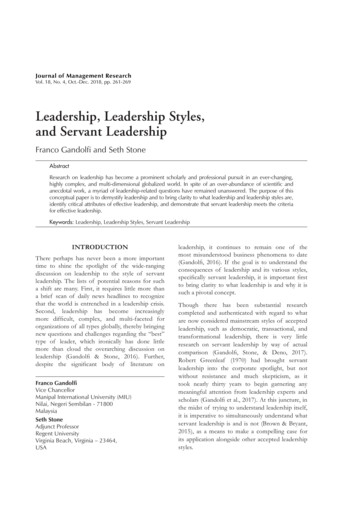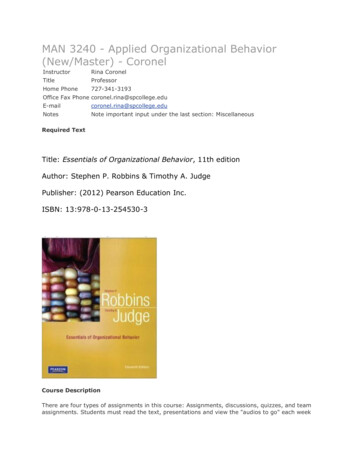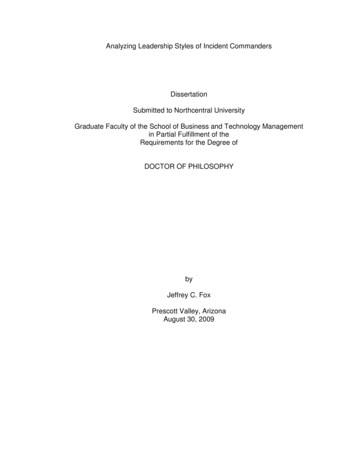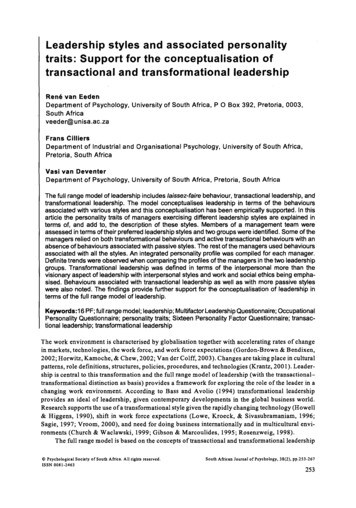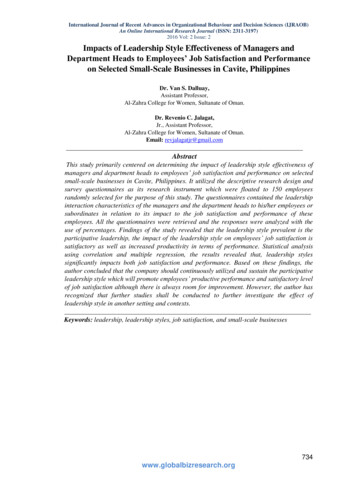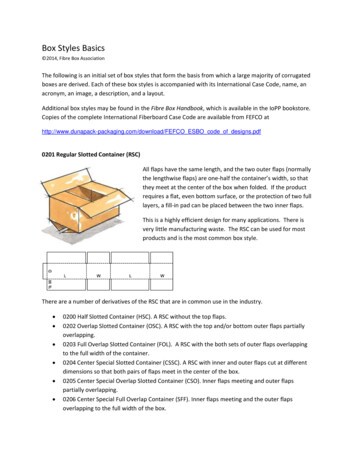
Transcription
A Handbook ofLeadership Styles
A Handbook ofLeadership StylesEdited byOzgur DemirtasCo-edited byMustafa Karaca
A Handbook of Leadership StylesEdited by Ozgur DemirtasCo-edited by Mustafa KaracaThis book first published 2020Cambridge Scholars PublishingLady Stephenson Library, Newcastle upon Tyne, NE6 2PA, UKBritish Library Cataloguing in Publication DataA catalogue record for this book is available from the British LibraryCopyright 2020 by Ozgur Demirtas, Mustafa Karaca and contributorsAll rights for this book reserved. No part of this book may be reproduced,stored in a retrieval system, or transmitted, in any form or by any means,electronic, mechanical, photocopying, recording or otherwise, withoutthe prior permission of the copyright owner.ISBN (10): 1-5275-4598-9ISBN (13): 978-1-5275-4598-4
TABLE OF CONTENTSList of Illustrations . viiiList of Tables . ixPreface . xChapter One. 1Leadership TheoriesD. Mehmet Bickes and Celal YilmazChapter Two . 35Leadership versus ManagementDeniz DirikChapter Three . 60Ethical LeadershipOzgur Demirtas, Mustafa Karaca and O. Faruk DerindagChapter Four . 84Transformational LeadershipO. Faruk DerindagChapter Five . 102Transactional LeadershipUfuk Basar, Unsal Sigri and Nejat BasimChapter Six . 126Participative LeadershipSerdar YenerChapter Seven . 149Servant LeadershipAli Bayram and Asli Geylan
viTable of ContentsChapter Eight . 167Charismatic LeadershipCoskun AkcaChapter Nine . 198Authentic LeadershipE. Gamze CiftciChapter Ten . 231Spiritual LeadershipSema PolatciChapter Eleven . 262Implicit And Explicit LeadershipMihriban Cindiloglu DemirerChapter Twelve. 294Autocratic LeadershipK. Emrah Yildirim, Caner Caki and Yasemin HarmanciChapter Thirteen . 311Democratic LeadershipInan EryilmazChapter Fourteen . 338Resonant LeadershipErdem ErciyesChapter Fifteen . 351Digital LeadershipBulent CizmeciChapter Sixteen. 368Cross-Cultural LeadershipMehmet Canakci and O. Faruk DerindagChapter Seventeen . 383Paternalistic LeadershipPinar Acar
A Handbook of Leadership StylesviiChapter Eighteen . 396Complexity LeadershipZeynep ErenChapter Nineteen . 429Coaching LeadershipGokmen Kara and Ozgur DemirtasList of Contributors . 453
LIST OF ILLUSTRATIONSFigure 1-1 . 9Figure 1-2 . 11Figure 1-3 . 12Figure 1-4 . 15Figure 1-5 . 17Figure 1-6 . 24Figure 1-7 . 25Figure 2-1 . 40Figure 2-2 . 41Figure 2-3 . 54Figure 6-1 . 129Figure 9-1 . 207Figure 9-2 . 212Figure 9-3 . 217Figure 10-1 . 243Figure 10-2 . 244Figure 10-3 . 245Figure 11-1 . 270Figure 11-2 . 281Figure 13-1 . 323Figure 14-1 . 343Figure 14-2 . 344Figure 14-3 . 345Figure 14-4 . 346Figure 15-1 . 356Figure 15-2 . 356Figure 15-3 . 358Figure 18-1 . 417Figure 18-2 . 421
LIST OF TABLESTable 1-1. 20Table 1-2. 21Table 2-1. 42Table 2-2. 49Table 3-1. 64Table 3-2. 68Table 3-3. 71Table 8-1. 180Table 8-2. 181Table 10-1. 248Table 11-1. 271Table 15-1. 358Table 17-1. 387Table 18-1. 403Table 18-2. 410Table 18-3. 420
PREFACEOne of the main reasons we wrote this book, Handbook of LeadershipStyles, was to highlight leadership styles in detail. Another reason is that alot of explanations of leadership styles exist, but there are few books thathave gathered these styles together in a detailed manner.The authors work mostly in the field of organizational behavior andthey mostly deal with leadership theory in their courses. Therefore, thebook has a strong academic background and it gives extensive suggestionsfor future research. In addition, the book explains some items forpractitioners.As we discuss in this book, the leadership phenomenon, whichembraces the economy, business community, and academia, has alwaysbeen a popular topic. This vigorous interest led to leadership being one ofthe most written about and discussed fields in academic and practitionercircles. Unlike other academic fields, everyone has a few words to sayabout leadership and management, which is a clear indication of how deepthe leadership concept is. This broad participation has actually revealed awealth of leadership, but it also has an impact that makes it difficult todevelop more refined and robust theories about leadership.The leadership capacities of managers play a key role in the success ofcompanies and even countries. Those who will serve as managers musthave certain leadership characteristics. Some of these features can belearned, while others are related to one’s character.In fact, one of the most important elements of leadership is the valueand authority of the position in the eyes of the followers. Thetransformation of the economy, our habits, and our mindsets make thetransformation of the leaders inevitable. New challenges and emergingneeds require new leadership approaches. These leadership approaches canwork for a certain time depending on the specific situation and the socialclimate. However, irresistible factors such as competition, technology, anddigital transformation require new leadership approaches and make thetransition between existing leadership styles more apparent than ever.We now live in a world where one or a few leadership approachescannot be presented as a recipe to organizations. This multi-layeredecosystem surrounding us increases the need for multidimensionalleadership styles but also emphasizes the need for new leadership styles.
A Handbook of Leadership StylesxiTherefore, it is not difficult to predict that leaders in charge of managingorganizations and teams today will have to acquire new capabilities in thenear future. The change in the classical business and workplace model, thefact that information becomes more valuable than the power of productionand that it is more difficult to capture consumers in multi-layered channelsshape the expectations of the leaders more sharply.In order to better comprehend the organic link between styles ofleadership, this book deals with almost all the leadership models to dateand thus demonstrates how dynamic the leadership actually is. This bookis an essential and extensive one-point reference for academics andpractitioners that combines all classical and contemporary types ofleadership styles in the same source.Ozgur DEMIRTAS
CHAPTER ONELEADERSHIP THEORIESD. MEHMET BICKES1 AND CELAL YILMAZ2AbstractOrganizations need a leader who has the required characteristics and skillsto sustain their existence, to grow and develop and to achieve their goals.Leadership is the process of facilitating individual and collective effortsand influencing others to achieve common goals. Leadership represents aprocess, while the leader refers to an individual. A leader can be defined asan individual who changes the paradigms of people, creates a vision,motivates followers with internal resources, engrains the idea thateveryone has something to contribute to the shared goal, leads them anddirectly affects the flow of events and results. When the literature isexamined, many studies on leaders and leadership exist, and the commonpurpose of these studies is to reveal facts and models about effectiveleaders and leadership. Many models have been developed on a theoreticalbasis to find an answer to the question of what makes leadership effective.In this section, within this scope, the nature, philosophy and terms ofleadership are discussed. Thereafter, the basic theories of leadership, thetheory of traits, behavioral leadership theories and situational leadershiptheories are examined. Finally, several implications and some suggestionsfor future research are provided for scientists, practitioners and others whoare interested in leadership.IntroductionLeadership a subject that has attracted the attention of people for centuries[1]. The term “leadership” refers to images of powerful and dynamic12Assoc. Prof., Nevsehir Hacı Bektas University, dmbickes@nevsehir.edu.trPh.D., Nevsehir Hacı Bektas University, cyilmaz@nevsehir.edu.tr
2Chapter Oneindividuals who command victorious armies, manage corporate empiresfrom the top of glittering skyscrapers or shape the future of nations. Theoutstanding achievements of brave and intelligent leaders are the essenceof many legends and myths. Historical descriptions are full of stories ofmilitary, political, social and religious leaders who are acclaimed for oraccused of important historical events, although it is unclear what effectsthe leaders have on the emergence and development of those events [2].Comments about leaders and leadership are first seen in the books ofConfucius (Analects), Lao-Tzu (Tao Te Ching) and Sun Tzu (The Art ofWar), dating back to the sixth century BC [3].Leadership, in parallel with developments, has become the mostcritical factor of organizational success or failure in every period of history[4]. Recent developments in the factors affecting business life havetransformed basic dynamics such as competition. In this process, social,human, and psychological capital types built on the human elements havecome to the fore, whereas the physical capital types, traditionalcompetition tools, though insufficient, are necessary for competition [5].Lucas [6] clarifies that the types of capital focusing on the humanelements have a two-way effect on productivity—internal influence, whichrefers to an increase in an individual’s own business performance, andexternal influence, which points to the increase of productivity in otherproduction factors shaped and managed by humans. In an organization, itis possible to divide the human elements into two groups as leaders andfollowers. Leaders stand out of the two groups as they have a decisivepower on employees’ perceptions, attitudes and behaviors [7] andimplicitly on organizational success. This fact is emphasized by Mihalcea[8] as “the basic condition for the effective management of social,political, economic and national structures or to achieve organizationalaims, is to have a leader with a high ability to adapt to environmentalconditions.” Otherwise, various problems can arise, such as avoiding goalsand facing vital risks when non-merit leaders are effective in the decisionmaking mechanisms of organizations.The leadership phenomenon has been of intense interest to humankindin every period of history. Bass [4] attributes this interest to the fact thatleadership is a universal activity for humanity and animals and vital foreffective organizational and social functioning. On the other hand, Wice[9] attributes this common interest in and admiration for leadership to thefact that it is a mysterious process, that nonetheless has a role ineveryone’s life. Systematic social scientific studies on leadership onlybegan in the 1900s; however, the phenomenon of leadership has longexisted and has attracted considerable attention [10]. When the literature is
Leadership Theories3viewed, many studies on leaders and leadership can be found, and thecommon purpose of these studies is to determine how a leader could bemore effective and successful. Many models have been developed to findan answer to this question on a theoretical basis. Ladkin [11] compareseach theory to “a piece of the leadership puzzle.” Therefore, it is possibleto argue that each developed theory and leadership style is a kind of lightthat reveals an unknown part of the subject. The literature shows that thedevelopment of leadership theories follows a chronological developmentparallel to the evolution of management approaches [12]. When the idea ofclassical management was developed in the early 1900s, the theory oftraits, suggesting that leaders with certain individual traits are moreeffective than others, emerged. In the 1940s, when the neoclassicalapproach dominated managerial philosophy, behavioral leadership theorieslinking the effectiveness of a leader to particular behaviors during theleadership process appeared. After the 1960s, when modern approachesdominated managerial philosophy, situational leadership theories—thatassert that leadership depends on a combination of circumstances—gainedimportance.These theories are the main theme of this chapter. The aim is toprovide information about leadership terms and leadership theories tostudents and academicians in this field and to practitioners or peopleinterested in theology, politics, civil society, military, sports and social lifein terms of leadership.Within this framework, first, the terms “leader” and “leadership” areparticularly discussed. Then the basic theories, traits, and behavioral andsituational leadership theories are scrutinized.1. Leadership TermsThe complex nature of leadership makes it impossible to achieve a specificand common definition [12]. Fiedler [13] and Stogdill [14] state that theexisting number of leadership definitions is as many as the number ofpsychologists working in the field. The reason for this abundance lies inthe individual perspectives of researchers and the characteristics of thephenomena they are interested in [2]. In addition, although it has beenstudied for many years, this area has not yet been fully formed [15]. Mostof the hundreds of leadership definitions [4] to date deal with one or moreof the following: goal achievement, the group or organization, its structure,and interpersonal relationships [16]. This situation, which stands out in thedefinitions, shows a strong relationship between leadership andorganization. Briefly, leadership exists in all organizations [17].
4Chapter OneThe word “leadership” is divided into three sections: “lead,” “-er” and“-ship.” The first part, “lead,” means being a pioneer or taking the firstplace. The second part, “-er,” refers to a person who performs a role orfunction or undertakes a responsibility. The last part, “-ship,” as in“scholarship,” refers to a skill, ability or art [18]. Based on thisinterpretation, leadership can be defined as determining a path that a groupwill follow, leading a group to reach a goal and owning the required skillset to mobilize followers with intrinsic motivation.Some theorists consider leadership as the role expertise of individuals,while others consider it a shared process among members [19]. Groon [20]identifies the first group of theorists’ conceptualizations as “focusedleadership” and the second group of theorists’ definitions as “distributedleadership.” Northouse [21] and Waters [22], two of the theorists in thefirst group, define leadership as a process in which an individual affects agroup of people to achieve a common goal. Similarly, Rue and Byars [23]define leadership as pursuing leader guidance willingly or an ability topersuade others to take over the decisions. Leadership in another source isconsidered to be the process of facilitating individual and collective effortsto achieve common goals and influencing others [24]. Gibb defines theleader as the person in the group who has a higher ability to influenceothers more effectively. However, the results of his empirical research onleadership in groups disprove this definition. The results reveal that theinfluence, which is accepted as leadership in the realization of any work, isnot limited to one person but moves within the group, depending onvarious task stages [11]. Groon [20–25] uses the “socially distributedactivity theory” to explain how leadership is conceptualized. This theoryargues that it is possible to monitor the movement of leadership amongindividuals who focus on the ideal of realizing shared goals, focusing onhow networks of interaction serve for it and what is done to achieve tasks.This perspective reveals the following three facts about leadership [11]: Leadership emerges as a process from the experience of individualsworking together. Leadership is not fixed for a single individual or an appointed“leader.” It moves predictably within groups of people. Leaders perform their duties invisibly and guide the conduct ofactivities without instructions and without specifying the source.Leadership is a phenomenon that exists with the approval of thefollowers, not the individual’s own claim. In this sense, Day [26] considersleadership as a socio-perceptual phenomenon and states that it is “in theeyes of beholders.” Lord and Maher [27] express leadership as the process
Leadership Theories5of being perceived by others as leaders.It is clear that leadership is defined using various aspects such as traits,leader behavior, interaction models, role relationships, followerperceptions, impact on followers, impact on task objectives and impact onorganizational culture in the literature [28]. The concept is built on aninfluence process no matter what perspective it is dealt with. However, itis a fact that the leaders differ significantly from one another in terms ofthe purpose of impact initiatives, implementation and process. In thissense, Yukl [19] argues that varieties in the definitions emerge not onlyfrom academic rigor but also from deep divisions in defining leadershipand explaining its process among the scientists studying this area.Although various definitions of leadership exist, they have severalcommon elements, such as influence, follower and vision [29–30]. One ofthe most important elements is influence, a key component of being aleader. Thus, Hogan et al. [31] describe leadership as persuading and donot see leadership as dominating with power and commanding others. Thesecond common element is followers. Leadership that creates trust,integrity and synergy for the group, as well as organizational and socialsuccess, is plural because the meaningful existence of the leader dependson the existence of the followers [32]. Blake and Mouton [33] defineleadership as the process of achieving goals through the contributions ofothers. In this definition, it is emphasized that it is possible to reach theaim only by the joint efforts of related people within and outside theorganization. In other words, no leader can achieve the goals set on theirown. The third common element is vision. Leaders have a vision of howthe organization will establish a better future and inspire their followers topursue the vision. Meticulously prepared visions are future-oriented,attractive, powerful, success-oriented, inspiring, convincing and accessible[34]. Vroom and Joga [29] list the common features of leadershipdefinitions as follows: Leadership is not a property owned by a person but a process. The process involves a special form of influence called motivation. The nature of intrinsic or extrinsic incentives is not part of thedefinition. The ultimate goal of the influence is to create collaboration topursue a common goal. “Great things” occur in the minds of the leader and followers. Theydo not have to be desirable to all other parties.As mentioned above, leadership refers to a process, while the leader is aperson. Allio [3] lists the main functions of leaders as clarifying goals and
6Chapter Onevalues, determining directions, creating communities and managingchange. In other words, leaders should develop a well-organized vision, aviable strategy, a focused plan and a measurable implementation processwithin the framework of a strategic management approach, and theyshould continuously monitor the environment and ensure compliancewhen doing all these activities and tasks. The term “leader,” within theframework of explanations, refers to the person who changes theparadigms of people, creates a vision, motivates followers with internalresources, engrains the idea that everyone has something to contribute tothe shared goal, leads them and directly affects the flow of events andresults.2. Leadership TheoriesWhen the literature is examined, it is seen that many studies have beenconducted to determine the basic dynamics of effective and successfulleadership, and many models have been developed on the theoretical basis[35]. Leadership theories follow a chronological development parallel tothe evolution of management approaches [12]. These theories are listedand explained below in chronological order: Trait theory Behavioral leadership theories Situational leadership theories2.1. Trait TheoryThe theory of traits states that there are some characteristics thatdistinguish the leader from the followers [36]. Basically, there are fourtypes of research to determine what these characteristics are [2]. The firsttype of research attempts to explore the characteristics and skills that aperson needs who will pursue a leadership career or as an informal leaderin a group. In some studies, the leader is compared with the non-leaders interms of characteristics and skills. Other studies focus on determining thecharacteristics and skills of those who emerge as leaders in problemsolving processes. The second type of research aims to determine the roleof talents and characteristics in the success of a leader in his currentposition. The third type of research is a long-term study that takes severalyears to determine the talents and characteristics of leading candidateswho deserve to rise to a higher position. The fourth type of research aimsto compare successful leaders. In these studies, the differences andsimilarities between managers who reach the top and the talents and
Leadership Theories7characteristics of managers who could not progress in their careersbecause of early retirement or plateauing (lack of chance for furtherdevelopment) are investigated.When considering the early studies in this theory, it is seen thatcharacteristics such as intelligence, dominance, self-confidence, energy,task knowledge and diligence are among the characteristics of a successfulleader [37]. In later studies, the characteristics traditionally associated witha leader include intelligence, endurance, stability and vision [38].However, when the studies conducted within the scope of the Trait Theoryare examined, it is obvious that the list of leader characteristics isgradually increasing [36, 37]. While some studies focus on characteristics,ranging from physical properties (height, weight, etc.) to personalities,some studies have expanded the range of traits to include handwritingstyles. Thus, it is clear that no consensus exists about effective leader traitsin the literature [12–36] and that the traits of a successful leader may varyaccording to the position [39]. Nevertheless, also observed in the literatureare several efforts to identify the major characteristics that distinguish asuccessful leader from the followers and to shorten the increasinglylengthy trait list. In one of these studies, the leading characteristics arelisted in eight topics: intelligence, alertness to the needs of others,wisdom/insight, initiative, responsibility, consistency of problem solving,self-confidence and sociability [40]. In another study, it is reduced to five,namely, intelligence, self-confidence, determination, integrity and sociality[18]. Although no clear consensus exists on the characteristics of asuccessful leader, many scientists, but not all, agree on these four traits:intelligence, maturity and breadth, success motivation and integrity [39].Leaders with significant and distinctive characteristics and talents can besuccessful in one case and may not be in another. Therefore, success cannotbe guaranteed by the characteristics [2]. For this reason, interest in thisapproach had disappeared for a long period. However, it has recently beenreplaced by a renewed “interest” [37]. In these studies, researchers aim toadd a limited number of characteristics to the leadership literature. Amongthese characteristics, emotional intelligence, drive, motivation, honesty,integrity, self-confidence, cognitive ability, business knowledge andcharisma are discussed [37]. Accord
PREFACE One of the main reasons we wrote this book, Handbook of Leadership Styles, was to highlight leadership styles in detail.Another reason is that a lot of explanations of leadership styles exist, but there are few books that

